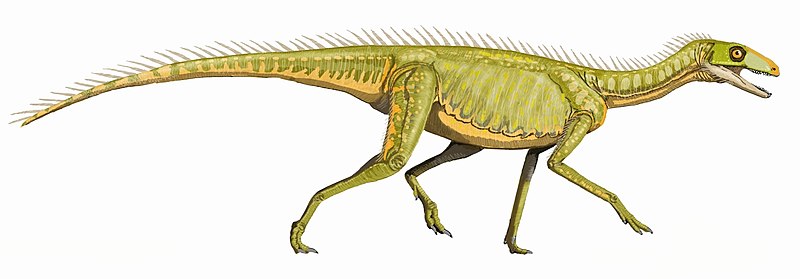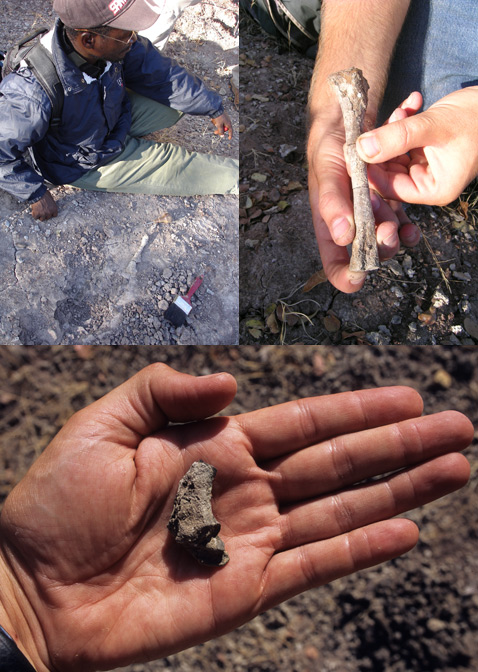[Recent Entries][Archive][Friends][User Info]
Below are the 4 most recent journal entries recorded in the "Сообщество, посвящённое ра" journal:| March 10th, 2012 | |
|---|---|
| 02:33 pm [industrialterro] [Link] |
Silesaurus Silesaurus is a genus of dinosauriform from the Late Triassic, approximately 230 million years ago in the Carnian faunal stage of what is now Poland. Fossilized remains of Silesaurus have been found in the Keuper Claystone in Krasiejów near Opole, Silesia, Poland, which is also the origin of its name. The type species, Silesaurus opolensis, was described by Jerzy Dzik in 2003. It is known from some 20 skeletons, making it one of the best-represented of the early dinosaurs and related animals. Silesaurus measured approximately 2.3 meters long (7.5 ft), and was facultatively bipedal. It was light and built for speed. Silesaurus was a herbivore. The teeth were small, conical, and serrated. The tip of the dentary has no teeth, and some paleontologists think that it may have been covered by a beak. Most scientists think that Silesaurus was not a dinosaur, but rather a dinosauriform. Dinosaurian features lacking in Silesaurus include an enlarged deltopectoral crest (a muscle attachment on the humerus), and epipophysis (enlarged tendon attachment above the postzygapophysis) on the cervical vertebrae. However, Silesaurus has some dinosaurian characteristics as well:
As a result, alternative theories place Silesaurus at or near the base of the ornithischian dinosaurs. Other scientists propose a basal link between the prosauropods and ornithischians.
Tags: Вымершие рептилии, Триас, авеметатарзалии, архозавроморфы, архозавры, диапсиды, динозавроморфы, силезавриды |
| 02:21 pm [industrialterro] [Link] |
Sacisaurus Sacisaurus (referred to in Portuguese as sacissauro) is a dinosauriform from the Late Triassic (Carnian to Norian) Caturrita Formation of southern Brazil. The scientific name refers to the city where the Sacisaurus was found, Agudo in the Rio Grande do Sul state and to Saci, a famous one-legged elf from Brazilian mythology, because the fossil skeleton has been found missing a leg. It was discovered in the geopark of Paleorrota. Sacisaurus was 1.5 meters (5 ft) long and 70 centimeters (2.3 ft) high. Its long and strong legs indicate that it was a fast animal. According to Jorge Ferigolo, paleontologist of Zoobothanic Foundation of Rio Grande do Sul state, the biggest teeth of the genus were 3 millimeters (1/12 in) long. The well-preserved jaw indicates that Sacisaurus was an herbivore, and there is a process at the tip that resembles the ornithischian predentary bone. Further research will attempt to define if Sacisaurus was the oldest ornithischian dinosaur. Through the cladistic analysis of some of its morphological particularities, its closest relative may be Diodorus. Sacisaurus was discovered in 2001 in the small municipality of Agudo, in the countryside of Rio Grande do Sul state. Through 50 bones, scientists could assemble the skeleton and speculate on how it might have lived. The fossil was presented for the first time in the 2nd Latin American Congress of Vertebrate Paleonthology in 2005. After the work of Brazilian scientists, the announcement of the discovery of the new species was made on November 1, 2006 at the University of São Paulo, Ribeirão Preto, where the bones were identified and the paper was published in the British scientific journal Historical Biology: A Journal of Paleobiology on October 30, 2006. The discovery helped scientists to study the feeding habits of dinosaurs and their close relatives, since it is one of the oldest ever found.
Tags: Вымершие рептилии, Триас, авеметатарзалии, архозавроморфы, архозавры, диапсиды, динозавроморфы, силезавриды |
| 02:16 pm [industrialterro] [Link] |
Lewisuchus Lewisuchus is a genus of archosaur that lived during the Middle Triassic (Ladinian); it was a silesaurid dinosauriform, a member of the group of reptiles which lead to the dinosaurs. Lewisuchus was about three feet long. Fossils have been found in Argentina. Some of the fossils originally assigned to Lewisuchus have since been moved to other genera, and the remaining portions closely resemble those of Pseudolagosuchus. A 2010 study in the Journal Nature indicated that the two may be synonymous. They were approximately the same size and came from the same locality and strata, but the fossil material is fragmentary and there is very little overlapping material. Since Lewisuchus was described 15 years before Pseudolagosuchus, if it is shown the two are synonymous (through the discovery of additional fossils) the name Lewisuchus would have priority.
Tags: Вымершие рептилии, Триас, авеметатарзалии, архозавроморфы, архозавры, диапсиды, динозавроморфы, силезавриды |
| 01:50 pm [industrialterro] [Link] |
Asilisaurus Asilisaurus ( Fossils were uncovered in Tanzania and date back to the Anisian stage of the Middle Triassic. It was described in 2010 by a team of researchers from the United States, Germany, and South Africa, in the journal Nature; the type species is A. kongwe. It is the first example of an avian-line radiation during the Anisian, with the diversification of archosaurs during this time previously only documented from crocodylian-line archosaurs. It was the first non-dinosaurian dinosauriform recovered from Africa. Asilisaurus measured from 1 to 3 metres (3 to 10 ft) long and 0.5 to 1 metre (2 to 3 ft) high at the hip, and weighed 10 to 30 kilograms (20 to 70 lb). Ученые нашли окаменелые останки самого древнего животного, образующего с динозаврами одну эволюционную ветвь, что говорит о более раннем, примерно на 10-15 миллионов лет, отделении предков динозавров от других типов животных, обитавших на доисторической Земле, сообщается в статье исследователей, опубликованной в четверг в журнале Nature. Обнаруженный вид животных получил название Asilisaurus kongwe - от asili ("предок" или "основание" на языке суахили), sauros ("ящер" на греческом ) и kongwe ("древний" на языке суахили). Он относится к животным из не так давно открытой группы силезавров (silesaurs), состоящих примерно в таком же родстве с динозаврами, в каком человек состоит с самыми близкими своими родственниками - шимпанзе. Асилизавр, по мнению ученых, жил примерно 243 миллиона лет назад, тогда как останки самого древнего динозавра, обнаруженные на данный момент, имеют возраст всего 230 миллионов лет. Это говорит о том, что общий предок динозавров отделился от остальных примитивных ящеров, потомками которых являются, например, современные крокодилы, существенно раньше, чем считалось прежде - около 250 миллионов лет назад. Асилизавры жили бок о бок с динозаврами на протяжении всего триасового периода - с 250 до 200 миллионов лет назад. Ученые теперь полагают, что другие родственники динозавров, такие, например, как летающие ящеры, тоже появились раньше, чем принято считать. Асилизавры были распространены на всех континентах мира, составлявших тогда единый суперматерик Пангею. Ведя раскопки в Танзании, авторы статьи - группа палеонтологов во главе со Стирлингом Несбиттом (Sterling Nesbitt) из Техасского университета в США, обнаружили останки сразу 14 особей асилизавров. Это позволило ученым практически полностью восстановить облик древнего родственника ископаемых рептилий. Асилизавр передвигался на четырех конечностях, был небольших размеров - не более 3 метров от кончика носа до кончика длинного хвоста, составлявшего до половины длины всего тела, и весил от 10 до 30 килограммов. У него была вытянутая морда с нижней челюстью, снабженная заостренным ороговевшим кончиком и рядом треугольных зубов. Авторы статьи полагают, что характерные черты асилизавра указывают на то, что это было травоядное или всеядное животное. До сих пор палеонтологи считали, что наиболее близкие предки динозавров были сугубо хищными животными и передвигались на двух лапах. "Асилизавр несет на себе черты, сильно отличающиеся от тех, что мы ожидали увидеть у родственника первых динозавров, особенно это касается его способности употреблять растительную пищу и перемещаться на четырех лапах", - сказал соавтор публикации Рэнделл Ирмис (Randall Irmis) из Университета Юты, слова которого приводит пресс-служба учебного заведения. Тот факт, что общие предки асилизавров и динозавров были сугубо хищными животными, указывает на три различных независимых пути эволюции и появления травоядных среди этих групп животных в течение всего 10 миллионов лет. Другими группами животных, освоившими питание растениями в этот период времени, были птицетазовые динозавры и динозавры из группы зауроподоморфов. Ученые полагают, что способность питаться растительной пищей дала животным эволюционные преимущества перед конкурентами, так как экосистема тех времен была представлена в основном хищниками, находившимися друг с другом в сильной конкуренции. Останки асилизавров были обнаружены среди останков других типов животных - примитивных родственников современных крокодилов, что говорит о более раннем и быстром разделении эволюционных ветвей этих животных, чем считалось прежде. "Наше исследование заставляет предположить, что в то время, примерно 250 миллионов лет назад, существовало больше групп животных, которые нам еще предстоит обнаружить. Чем больше мы о них узнаем, тем больше мы понимаем о появлении и эволюции самих динозавров и других групп животных", - подытожил Ирмис. Значимость открытия Asilisaurus kongwe не только в том, что он проливает свет на раннюю эволюцию силезавров, но и в том, что он позволяет лучше понять эволюцию всей группы динозавроморфных архозавров. Ранее палеонтологи предполагали, что все предки динозавров и их ближайшие родственники в начале и середине триаса были хищниками и, преимущественно, двуногими. Но открытие силезавров и вот теперь обнаружение Asilisaurus kongwe показало, что экологическое разнообразие внутри группы орнитодир (Ornithodira) в триасе было значительно большим. Здесь необходимо пояснить, что орнитодиры – большая группа архозавров, в которую ученые объединяют птерозавров, динозавроморфных архозавров, а некоторые – сторонники теории происхождения птиц от динозавров - добавляют в нее и птиц. The fossils range in age from the Anisian to the Norian stages of the Triassic, about 245 to 203 million years ago. Among the members of the Silesauridae were Silesaurus (which lends its name to the family), Pseudolagosuchus, Lewisuchus, Asilisaurus, Technosaurus, Eucoelophysis, Sacisaurus, and Diodorus.
Размеры тела в сравнении с человеком:
Tags: Вымершие рептилии, Триас, авеметатарзалии, архозавроморфы, архозавры, диапсиды, динозавроморфы, силезавриды |















